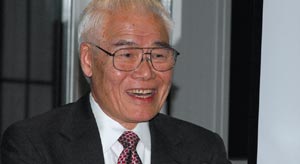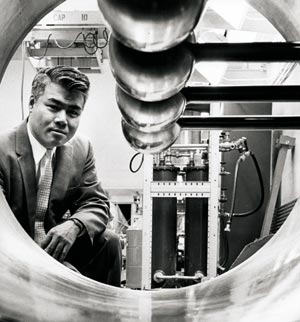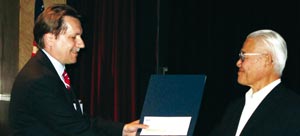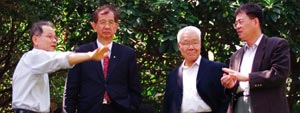Diana Li looks at the long career of an accelerator pioneer.
Résumé
Lee Teng: une carrière passionnée dans les accélérateurs
Cette année, la Société américaine de physique a décerné le prix Robert R Wilson de la meilleure réalisation en physique des accélérateurs de particules à Lee Teng, du Laboratoire national d’Argonne. Ce prix marque non seulement l’apogée d’une carrière prestigieuse, mais reflète aussi un parcours de 60 ans, qui a commencé en 1947, lorsque Teng a quitté la Chine pour les États-Unis. Sa carrière, qui a débuté au Synchrocyclotron Fermi, à Chicago, illustre les cinquante dernières années des accélérateurs de particules, car il a déployé sa créativité dans tout le domaine, notamment en inventant l’extraction résonnante et en dirigeant la conception d’une installation de protothérapie.
Each year, the American Physical Society (APS) confers awards to outstanding researchers across the field of physics. This year, those honoured include Lee Teng, senior physicist emeritus at the Advanced Photon Source, Argonne National Laboratory (ANL). Officially, the award is for his inventions, not his passion. Unofficially, everyone who knows Teng knows him for his passion for speed – particle speed, that is – and for his sincere desire to direct his passion for the benefit of the public.
Teng received the 2007 Robert R Wilson Prize for achievement in the physics of particle accelerators during the 22nd Particle Accelerator Conference in Albuquerque (see “Accelerator experts meet in Albuquerque“). The APS honoured him for "the invention of resonant extraction and transition-crossing techniques critical to hadron synchrotrons and storage rings; for early and continued development of linear matrix theory of particle beams; and for leadership in the realization of a facility for radiation therapy with protons." The award not only marks the zenith of a distinguished career, but also a 60-year journey that began in 1947 when Teng arrived in the US from China.

Image credit: Mike Borland.
Reviewing Teng’s career is like studying the history of particle accelerators of the past 50 years. "I am very blessed to have been involved with particle accelerators at this time. The field witnessed great advances and I was able to contribute to all phases of the progress," says Teng. "Since the early development of particle accelerators in the 1930s, there have been significant breakthroughs every five years or so, and we have experienced rapid progress with tremendous momentum."

Image credit: ANL/AIP Emilio Segrè Visual Archives.
Starting out at the University of Chicago, Teng worked as a graduate assistant on the "Fermi" synchrocyclotron project, which at the time was the most powerful accelerator available. It was there that he made his first major achievement, discovering the method of "regenerative extraction" – now known as "resonant extraction" – to extract the beam after the proton is accelerated. To this day, this is the only beam extraction system for cyclotrons, with an extraction efficiency of nearly 50%.
Teng obtained his PhD from the University of Chicago in 1951 and he soon joined the University of Minnesota, as the university was in the midst of building a linear proton accelerator. To increase beam intensity, Teng designed a quadrupole focusing system for the linac using a matrix formulation derived from his regenerative extraction system – the first application of a matrix formulation to alternating gradient focusing systems.

Image credit: APS.
Teng joined ANL in 1955 after a short period at Wichita State University. He rose to become director of the particle accelerator division in 1961, responsible for constructing and operating the Zero Gradient Synchrotron (ZGS) and the associated beam transport lines and bubble chambers. During his tenure, the division accomplished several important innovations in accelerator design and operation, making the ZGS the highest-energy weak-focusing synchrotron ever built – and possibly the last.
If passion plays a role in Teng’s adventure in exploring the world of particle accelerators, it is his risk-taking, sound judgement, and willingness to step forward that make him stand out from the crowd. He joined Fermilab in 1967 as the head of accelerator theory and remained there for 22 years. During this time, Teng witnessed the changing world of accelerators and anticipated the enhancement of synchrotrons from 70 to 900 GeV, including Fermilab’s launch of the world’s first superconducting accelerator in February 1984. He served briefly as the associated director of the Accelerator Division in the early 1980s, later becoming head of the Advanced Accelerator Project.
Once the commissioning of the Tevatron collider system had passed smoothly, Teng began to look for projects that required shorter construction times and delivered faster pay-offs than high-energy machines. It was then that his life took another turn, parting from the exciting frontier of high-energy physics to choose an avenue that he hoped would "make something that is more immediately useful for human lives".

Image credit: NSRCC.
This change in direction led him to Asia, and he took a two-year partial leave of absence from Fermilab in 1983 to serve as the founding director of what is now the National Synchrotron Radiation Research Centre (NSRRC) in Taiwan. He led the design and construction of the first third-generation synchrotron radiation facility in Asia. The Taiwan Light Source boasted more than 7000 running hours a year after its completion in 1993, and more than 95% reliability. It now has 30 beamlines and nearly 1500 scientists and students use it. In 2004, the NSRRC began the planning of a second facility, a 3-GeV synchrotron radiation source.
Back at Fermilab, in a meeting of the Proton Therapy Coordination Group in 1986, Jim Slater, the head of the radiology department of Loma Linda Hospital in California, proposed that Fermilab should design and build a proton accelerator for cancer therapy. Teng, naturally, took on the project. The accelerator had to provide a rapidly variable energy up to 250 MeV and an extracted beam with a uniform long spill for raster-scan irradiation across tumours. By choosing a weak-focusing synchrotron with slow resonant extraction, Teng’s design fulfilled the criteria. The facility established Loma Linda as the first hospital with a clinical capability for proton therapy. The entire project took nearly two years, and during that time Teng had to learn a great deal about the techniques and standards of radiation oncology.
In 1989, the project for the new 7-GeV Advanced Photon Source started at ANL and the laboratory invited Teng back as head of the project’s accelerator physics contingent. He retired 15 years later (in 2004), but maintains his association with ANL through his honorary appointment as emeritus senior scientist. He also remains a member of the board of trustees of the NSRRC and travels to China at least once a year to serve on review and advisory committees and to give talks at workshops or conferences.
Back in 1947, when Teng arrived in the US, the only tools available to physicists were essentially pencils and calculators. Creativity was clearly the main force driving progress. In turn, passion proved to be the driving force behind Teng’s unique creativity in accelerator physics. He has met the increasingly challenging needs of accelerator technology by collaborating with, among others, Brookhaven National Laboratory, Los Alamos National Laboratory, TRIUMF, KEK, the Budker Institute of Nuclear Physics and CERN. His interest in problem solving has never faded over the years, and this has been a blessing for the design of modern accelerators.








